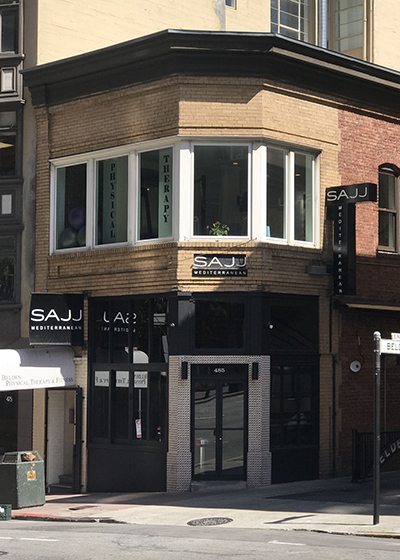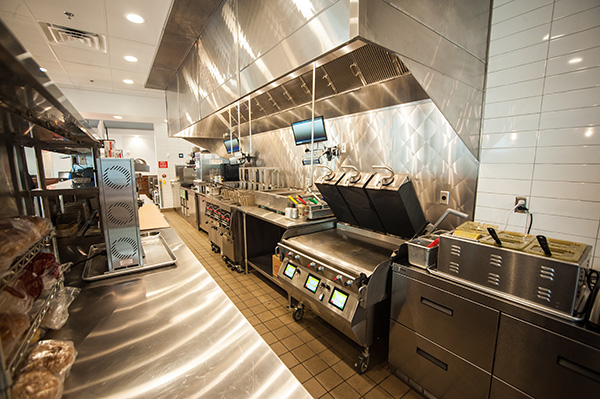Unlike a building’s facade, which is the external appearance and relates more to a style or design, external cladding not only serves as a protective layer but also adds embellishments or enhancements to the outside of a restaurant. Thus, it is functional while also being decorative. This construction method includes materials attached to the actual building.
A building’s exterior is a billboard. At the primary level, it creates a shelter and safe space, but cladding also helps connect the building to its community and environment. For restaurants, a story or narrative can be created by incorporating different materials. It also can bring cohesiveness by connecting to a brand or concept.
The appropriate type of cladding is dependent on the location, weather and overall environment. Aesthetics and budget are also factors.
Architectural cladding may incorporate insulation material, which helps with energy efficiency as this keeps interior temperatures consistent. There is typically a waterproof structural wall behind it or a waterproof layer included to ensure the building is up to code.
Cladding provides added protection to the building, helping repel water and wind. Depending on the material used, it can minimize maintenance and add a longer life to a building’s exterior. Cladding also adds to a restaurant’s aesthetics, complementing or extending interior decor or enhancing brand recognition. In addition, it can be more easily changed than a facade.
Material Types
While materials like cement blocks or bricks can serve double duty as cladding that’s decorative and a sturdy building foundation, other popular types like stainless-steel panels, ceramic tiles and fiber board are more for aesthetics than function.
Because vinyl cladding is one of the most durable external materials available, it is commonly used. This type is easily installed over an existing facade, provides UV protection, resists water and sea salt and withstands high winds, heat and cold. Available in various textures and colors, it is affordable and low maintenance.
Stone cladding, including marble, slate and sandstone, is cut in consistent sizes and used in thin layers. Stones are moisture resistant and nonporous, so this type provides added protection and years of use. By the same token, brick cladding is attractive, provides added durability, multiple color options and requires minimal maintenance.
Unplasticized polyvinyl chloride (UPVC) cladding is maintenance-free and comes with a UV stabilizer to withstand direct sunlight. This material handles extreme weather conditions, is fire-
resistant for added safety and, when installed correctly, will insulate buildings from cold and hot temperatures.
Timber cladding, such as redwood and cedar, has become more common due to its natural appearance and sustainability. It’s also versatile, with a variety of styles, colors and textures that can complement interior aesthetics or stand out on its own. Wood can be hard, soft, reclaimed or engineered to fit different budgets.
Metal cladding in stainless steel or aluminum is affordable and durable for years of use with minimal maintenance required. Along with fire resistance and building insulation, this type provides various designs, colors and textures.
Concrete cladding in panel or tile formats is easily molded to different shapes and sizes. A newer type that is durable, concrete stands up to the elements and is practically maintenance free.
Classic stucco or exterior plaster is a baseline cladding that is versatile. It can be finished in different ways with various colors and textures.
Weatherboard or featheredge cladding is made of timber and provides various colors and textures. Because this type requires more difficult horizontal installation as opposed to vertical, it’s key that it is put up by only seasoned professionals.
Exterior insulation and finish system (EIFS) is a non-load bearing building cladding system with a protective barrier that’s waterproof. It offers many colors and designs. This type can be customized and provide a wood look for more upscale designs.
Less common but unique, glass cladding is affordable, has a high-end look and is environmentally friendly.
When choosing materials, the goal of the exterior should be kept in mind. For example, reclaimed wood, concrete, stone, and metal contribute to a building’s aesthetics and are sustainable while providing longevity. The downside is that these types can be more costly.
Materials can morph into different looks. For example, there is tile cladding that looks like stone and brick cladding with a metal appearance.
Trends and Innovations
EIFS is not new, and it isn’t a common type of cladding, but it has become popular for those seeking more customization with the exterior.
There are new, sustainable cladding options that use recycled plastic, leftover sawdust and other materials that would normally be thrown away. Panels created out of various recycled materials are very durable to withstand harsh weather and can be customized.
There have been cladding innovations that provide unique materials and formats from a designer’s perspective. For example, wood siding can include larger boards installed first and battens at the joints. Materials also can be installed vertically, horizontally or at 45-degree angles diagonally to enhance a material’s graphic nature.
In the last decade, energy codes have become more stringent to include insulation on the outside of wall cavities or increased insulation on inside walls. Rain screen systems on the exterior behind the cladding allow air circulation to help deal with moisture issues and also will passively cool buildings.
Purchasing Considerations
Operators are essentially broadcasting intentions through a building’s exterior. Most customers recognize quality and attention to detail, with sharp looking buildings making a good first impression.
Cladding could be foundational to a building but also may be part of its aesthetic, depending on what the operator is trying to achieve. While brick, stone and other waterproof material can stand alone, most other cladding that is added separately and not integral to the building is an extra external layer that requires a water barrier. In this case, rain screens, especially on back walls, are needed. This can be tricky in cases where more than one type of cladding is used, which has become common.
It’s essential to consider the budget, up front costs, environment and aesthetics when choosing cladding. Consider lifecycle costs and long-term maintenance when looking at the initial investment. What’s most important is how cladding performs over the restaurant’s lifespan, as it is an investment that brings added value.
Wind loads and UV rays in sunnier states would not bode well for some materials, such as wood, which also has high maintenance requirements. Brick, stone and EIFS are sturdy and require minimal maintenance with just hosing off to clean. Newer cladding options, such as fibrous cement boards and metal panels, also are low maintenance and easy to clean but not as durable.
City, county and state code compliances should be followed to ensure the design and materials adhere to local requirements.
Both glass panel and brick tile
cladding require up-sands, which ensure the cladding will not only stick to the building’s exterior but also withstand high winds.
Cleaning and maintenance
Cleaning and maintenance requirements depend on the cladding materials. Those operators with minimal time and smaller budgets should seek a type that is lower maintenance.
Look at the environmental exposure and location. Note that cladding with a western exposure will be beat on in the afternoon by the sun. In this case, natural painted wood wouldn’t be recommended unless continuous sanding and repainting isn’t an issue. Brick, stucco or fiber cement are all sturdier and lower maintenance options.
Cladding adjacent to outside seating areas should use an easily cleaned and durable material so as not to look worn from the outside elements. +



